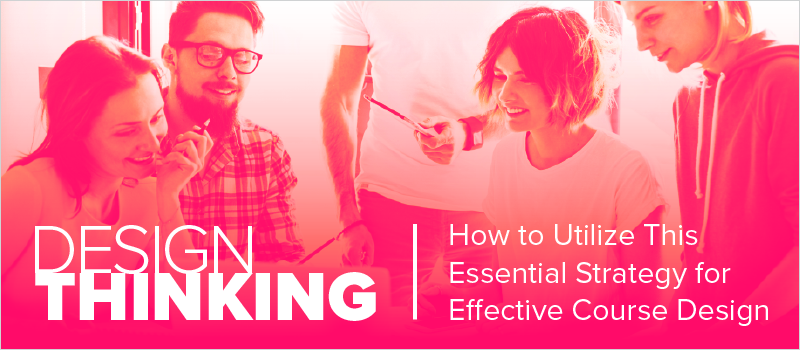
“We spend a lot of time designing the bridge, but not enough time thinking about the people who are crossing it.”
- Dr. Prabhjot Singh
Design thinking is about placing the end-user at the core of everything you do. This includes your overall approach to the philosophy of design, and also the practical workflows you follow during the design process.
● Focuses on the user
● Challenges assumptions
● Redefines problems
The aim is to identify alternative strategies so you can find the best, most user-centric solution. It’s a way of thinking and working, but also a collection of hands-on methods.
As a concept, it is not specific to eLearning, but it’s an approach that has become a popular topic of conversation in L&D as corporate training departments search for ways to provide more engaging learning experiences for employees.
Combining the old with the new
Traditional instructional design models tend to be analytical in nature and have their basis in systems thinking. But the work of L&D leaders is also very innovative and creative. Course design needs to adhere to proven methodologies, but learners want to be engaged and inspired to learn. With design thinking, these two approaches can work alongside each other.
“Meeting learners where they are” was listed as one of the top priorities for learning departments in LinkedIn’s 2019 Workplace Learning Report. Instructional design practices need to evolve with the modern workplace in order to create timely and engaging training.
A hands-on approach to design thinking
There are many ways to interpret design thinking. One of the most popular approaches was taught by Stanford’s d.school and endorsed by the Interaction Design Foundation. It consists of five phases:
1. Empathize
Today’s instructional designers need to understand the feelings of their learners - to place themselves in the shoes of the employee in order to fully understand their goals, challenges, and perspectives.
Such understanding can have far-reaching effects on the course, such as the level of language, choice of multimedia elements, style of assessments, and other aspects of course design.
2. Define
Businesses often prefer to define a problem in terms of numbers, but design thinking also allows for the inclusion of qualitative aspects. The more distinctly you define the problem, the stronger your focus will be when it comes to building course elements.
3. Ideate
The Ideate stage is where the team generates potential solutions to the problem identified in the Define stage. Try to generate as many ideas as possible—all ideas should be considered and evaluated. It’s about leveraging the combined synergy of the group so increasingly creative solutions can be brought to the table.
4. Prototype
A prototype is simply a rough draft or preliminary version of an approach that provides a way to rapidly try out ideas. It should be an iterative process as the aim is to “fail” as quickly as possible. The idea is that each failure and adjustment brings you closer to the end design.
5. Test
Design thinking as a whole should be an iterative process. It should involve lots of testing and modification. The Test phase of design thinking is often highly intertwined with the Prototype phase. It’s all about seeing what works in reality, processing feedback, and refining (or ditching) design prototypes.
“Corporations are shifting to experience-based businesses, and learning is no different: we need to focus on the experience of the learner in order to be successful.”
- Travis Jordan, CEO, Instructional Design Central
How does design thinking fit in with instructional design?
Employed correctly, design thinking should be empathetic and iterative; two traits that are increasingly recognized as being of vital importance in learning and development. Design thinking does not replace instructional design but it can enhance and work in tandem with instructional design techniques.
For example, the Empathize and Define phases of design thinking can be used in the Analysis phase of ADDIE. Similarly, the Ideate and Prototype phases of design thinking can be correlated with the Design and Development phases of ADDIE.
The business benefits of design thinking
In Deloitte’s 2016 Global Human Capital Trends report, 79% of respondents rated design thinking as an important or very important issue.
Design thinking moves L&D’s focus beyond simply building training programs to a new goal: designing meaningful learning experiences through solutions that are compelling, enjoyable, and productive for employees and for the business.
Instructional design is now learning experience design
With these techniques, L&D can move from serving as a “process developer” to an “experience architect.” Design thinking encourages learning professionals to reimagine every aspect of corporate training, including how, when, and where they present and evaluate a learner’s experience.
Today’s most successful L&D managers build courses with learning experience in mind. Design thinking incorporates empathy and iteration into the instructional design process. Combined with the right technology, learning professionals can deliver the most effective experiences possible by incorporating design thinking into training development.
Want to learn more about essential strategies for effective course design? Synapse and eLearning Brothers are teaming up for a webinar to discuss exactly that.
Guest Author - Ryan Austin
Ryan Austin is a serial entrepreneur who has spent over 10 years driving improvements in learning and development. In his current role as CEO at Synapse, a Learning Design System, Ryan is focused on developing innovative products to streamline the instructional design process so learning teams can create impactful training at scale. Prior to Synapse, Ryan served as Senior Vice President for World Trade Group, an organization that offers live events, online products, and training courses. He was responsible for the start-up, development, design, and execution of the Training Division in the Americas, which demonstrated outstanding success.
Learn More About Synapse








